Intel Alder Lake DDR5 Memory Scaling Analysis With G.Skill Trident Z5
by Gavin Bonshor on December 23, 2021 9:00 AM ESTScaled Gaming Performance: Low Resolution
Civilization 6
Originally penned by Sid Meier and his team, the Civilization series of turn-based strategy games are a cult classic, and many an excuse for an all-nighter trying to get Gandhi to declare war on you due to an integer underflow. Truth be told I never actually played the first version, but I have played every edition from the second to the sixth, including the fourth as voiced by the late Leonard Nimoy, and it is a game that is easy to pick up, but hard to master.
Benchmarking Civilization has always been somewhat of an oxymoron – for a turn based strategy game, the frame rate is not necessarily the important thing here and even in the right mood, something as low as 5 frames per second can be enough. With Civilization 6 however, Firaxis went hardcore on visual fidelity, trying to pull you into the game. As a result, Civilization can taxing on graphics and CPUs as we crank up the details, especially in DirectX 12.
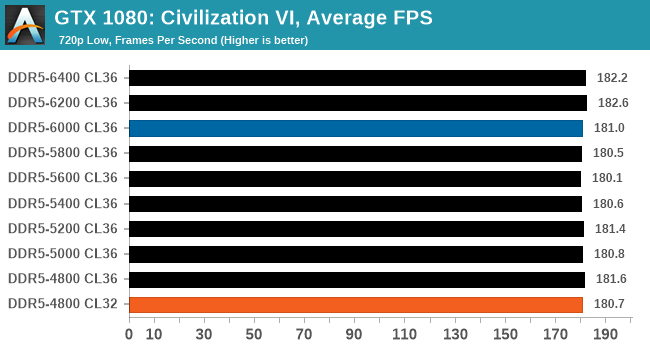

Blue is XMP; Orange is JEDEC at Low CL
Performance in Civ VI shows there is some benefit to be had by going from DDR5-4800 to DDR5-6400. The results also show that Civ VI can benefit from lower latencies, with DDR5-4800 at CL32 performing similar to DDR5-5400 CL36.
Shadow of the Tomb Raider (DX12)
The latest installment of the Tomb Raider franchise does less rising and lurks more in the shadows with Shadow of the Tomb Raider. As expected this action-adventure follows Lara Croft which is the main protagonist of the franchise as she muscles through the Mesoamerican and South American regions looking to stop a Mayan apocalyptic she herself unleashed. Shadow of the Tomb Raider is the direct sequel to the previous Rise of the Tomb Raider and was developed by Eidos Montreal and Crystal Dynamics and was published by Square Enix which hit shelves across multiple platforms in September 2018. This title effectively closes the Lara Croft Origins story and has received critical acclaims upon its release.
The integrated Shadow of the Tomb Raider benchmark is similar to that of the previous game Rise of the Tomb Raider, which we have used in our previous benchmarking suite. The newer Shadow of the Tomb Raider uses DirectX 11 and 12, with this particular title being touted as having one of the best implementations of DirectX 12 of any game released so far.
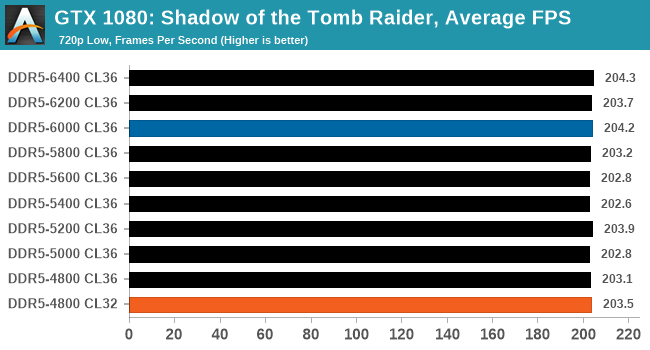
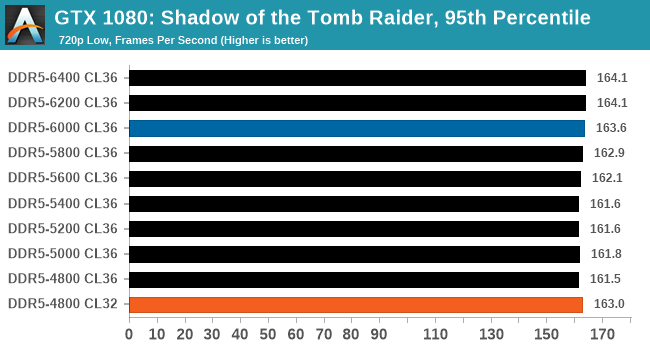
Blue is XMP; Orange is JEDEC at Low CL
In Shadow of the Tomb Raider, we saw a consistent bump in performance in both average and the 95th percentiles as we tested each frequency. Testing at DDR5-4800 CL32, we saw decent gains in performance over DDR5-4800 CL36, with the lower latencies outperforming DDR5-5800 CL36 in both average and 95th percentile.
Strange Brigade (DX12)
Strange Brigade is based in 1903’s Egypt and follows a story which is very similar to that of the Mummy film franchise. This particular third-person shooter is developed by Rebellion Developments which is more widely known for games such as the Sniper Elite and Alien vs Predator series. The game follows the hunt for Seteki the Witch Queen who has arisen once again and the only ‘troop’ who can ultimately stop her. Gameplay is cooperative-centric with a wide variety of different levels and many puzzles which need solving by the British colonial Secret Service agents sent to put an end to her reign of barbaric and brutality.
The game supports both the DirectX 12 and Vulkan APIs and houses its own built-in benchmark which offers various options up for customization including textures, anti-aliasing, reflections, draw distance and even allows users to enable or disable motion blur, ambient occlusion and tessellation among others. AMD has boasted previously that Strange Brigade is part of its Vulkan API implementation offering scalability for AMD multi-graphics card configurations. For our testing, we use the DirectX 12 benchmark.
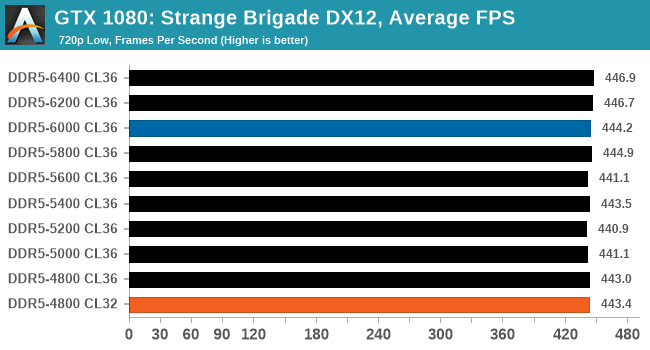
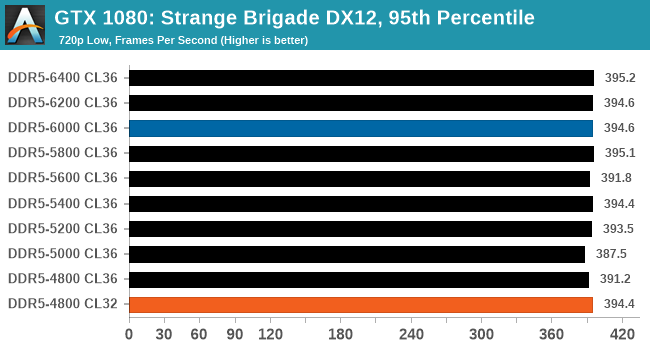
Blue is XMP; Orange is JEDEC at Low CL
Performance in Strange Brigade shows there is some benefit to higher frequencies, with DDR5-6400 CL36 consistently outperforming DDR5-4800 to DDR5-6200 CL36. The biggest benefit came in 95th percentile performance, with DDR5-4800 at lower latencies of CL32 coming close to DDR5-5800 performance.


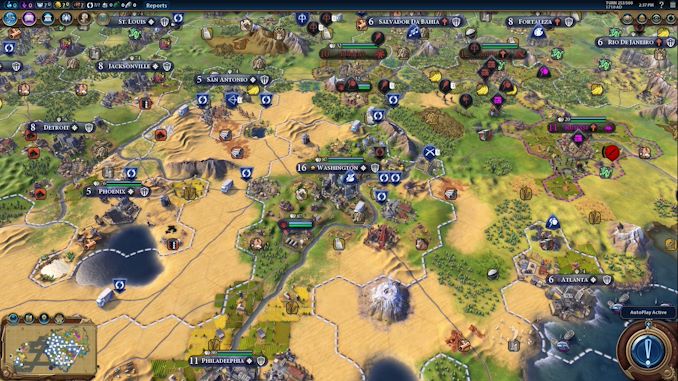
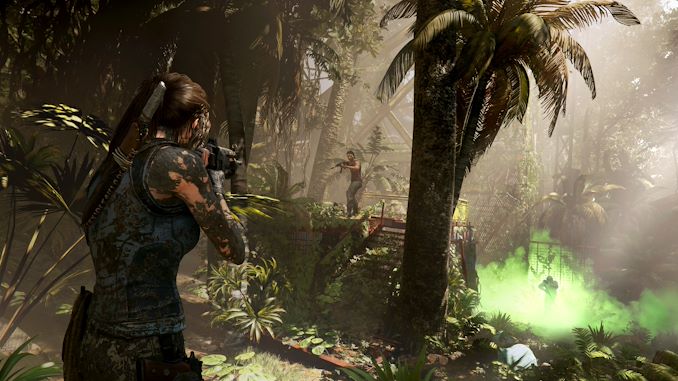









82 Comments
View All Comments
Makaveli - Thursday, December 23, 2021 - link
I'd have to agree I'm not sure about the component choices here. Tech spot same article today provide alittle more useful information when it comes to games.https://www.techspot.com/review/2387-ddr4-vs-ddr5/
Notmyusualid - Thursday, December 23, 2021 - link
I'd have to disagree.7 of the top 10 GPUs in usage on this months Steam H/W survey are all deployed with Nvidia's Pascal architecture.
So clearly, for most gamers, the results contained here are relevant.
As to your other comment - my buddy runs 3440x1440 on his Seahawk (w/c) 1080, and it runs very well indeed.
Makaveli - Thursday, December 23, 2021 - link
3440x1440p with a 1080 at ultra settings?at 144hz? And what games? that comment doesn't have any details.
mikk - Thursday, December 23, 2021 - link
By this logic they shouldn't even bother testing a 12900k or any other ADL-S, the market share is even lower on Steam, much lower. It makes no sense what you are saying. The chance someone combines a new 12900k with an old GTX 1080 is rather slim, only Anandtech does this. This RAM test in heavy GPU limit is a complete waste of time. A typical Anandtech test.Oxford Guy - Friday, December 24, 2021 - link
I have a Fury-X that I obtained used for a low price coupled with a 9700K. Not everyone is willing to pay obscene prices for PC GPUs.TheinsanegamerN - Monday, January 3, 2022 - link
The price people are willing to pay has absolutely nothing to do with scaling performance reviews. Talk about a red herring argument.TheinsanegamerN - Tuesday, December 28, 2021 - link
Yes, but this is not a GPU test, it is a RAM scaling test. Running GPU limited scenarios is not going to provide useful data for RAM scaling.Oxford Guy - Friday, December 24, 2021 - link
It’s fine data, hardly useless. It’s incomplete, though.dicobalt - Thursday, December 23, 2021 - link
DDR5's latency is higher than 1970s Ozzy Osbourne.bananaforscale - Thursday, December 30, 2021 - link
Those are cycles, not time.